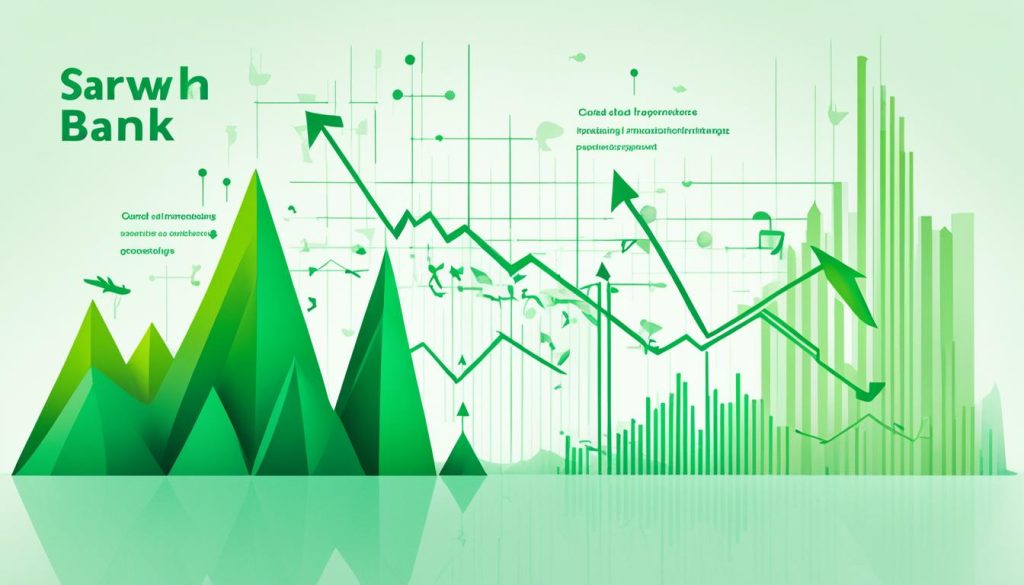The Nordic banking sector is changing a lot, especially with sustainable banking. As 2024 gets closer, big changes and rules are pushing Nordic banks to focus more on being sustainable. This includes using ESG criteria and aiming for net-zero carbon emissions. The way banks are structured financially is also changing due to sustainability risks.
Data strategies and plans for change are now very important for understanding Nordic financial markets. This is especially true for professionals in the UK who work with regulations, sustainability, and managing data.
Key Takeaways
- Nordic banks are prioritising sustainable banking practices for 2024 and beyond.
- ESG criteria and net-zero commitments are central to these efforts.
- Changes in banking capital structures are highly influenced by sustainability risks.
- UK stakeholders in regulatory, sustainability, and data management roles are directly impacted.
- Comprehensive data strategies and transition plans are essential for success.
Overview of Nordic Finance and Banking

The Nordic banking industry is famous worldwide for its strong focus on sustainable finance. It’s led by Scandinavia’s top banks, which aim to promote economic growth and stability. They work hard to keep up with laws and the global financial scene.
Introduction to the Nordic Banking Sector
Nordic banks are seen as some of the most innovative and responsible in the world. They are well-funded and careful about risks, helping to keep the region’s economy healthy. Their commitment to being green and sustainable makes them stand out globally.
Key Players in the Region
Major banks like Nordea, Swedbank, Handelsbanken, and DNB lead the Nordic finance scene. They use the latest tech and good management to drive growth and sustainability. Their efforts have a big impact on banking across Europe.
Recent Developments in Nordic Finance
Recent trends in Nordic banking show a move towards being more responsible and green. Banks now focus more on sustainable finance and include ESG factors in their work. There’s also a big push for digital services, making things more efficient and improving customer service. This helps the Nordic region grow in a sustainable way.</lectrician
Sustainable Finance Strategies in the Nordic Region

The Nordic region is deeply committed to sustainable finance. Their focus is on improving Environmental, Social, and Governance (ESG) practices. This effort is supported by strong rules that ensure everyone meets sustainability goals.
Importance of ESG Criteria
ESG investing is key in Nordic banking for sustainable finance. Banks there work to bring ESG standards into their investment and lending methods. This boosts investor trust and ensures their services meet expected sustainability standards.
Regulatory Landscape and Compliance
New rules for green finance are always coming up, like the Corporate Sustainability Reporting Directive (CSRD). Following these strict rules is a must. It makes banking more transparent and responsible, meeting global sustainability standards.
Nordic Banks’ Commitment to Net-Zero Targets
Nordic banks lead with bold net-zero strategies. They are cutting the carbon emissions from their services and loans. By doing this, they help meet global climate targets, promoting sustainable growth and stable finances in the area.
Technological Innovations Shaping Nordic Banking

In Nordic banking, new technologies are making a big difference. Banks are using Fintech in Nordic countries to stay ahead. This change is making banking quicker and more effective.
Digital banking advancements lead this change. Nordic banks are creating easy-to-use mobile apps and AI for financial advice. Customers who like technology find these services fast, reliable, and safe.
Also, this shift affects how banks work on the inside. They use blockchain to make transactions safer and cheaper. Robot software is making everyday jobs more efficient, too.
By mixing digital banking advancements with Fintech in Nordic countries, these banks are leading in innovation. They are ready for today’s tasks and those of the future.
Challenges Faced by Nordic Banks in 2024

In 2024, Nordic banks are facing big hurdles that call for clever thinking and strong action. They are dealing with tough rules and economic troubles.
Regulatory Pressures
Bank rules are getting stricter, pushing Nordic banks to adjust quickly. They need to spend a lot of resources and plan carefully to meet these regulations. This makes running a bank more complex and costly.
Economic Headheads
Nordic banks are also hit by economic problems. They might lose money on loans, earn less from interest, and face other challenges. To stay ahead, they have to get better at managing risks and cutting costs. It’s crucial to keep making money while dealing with these economic ups and downs.
Implications for UK Investors in Nordic Banking

The Nordic banking sector stands out in the Nordic region. It offers great opportunities for UK investors. These banks are well-known for their strong performance and focus on sustainability.
Investment Opportunities
UK investors find Nordic banks appealing because they are strong and reliable. They offer various investment options like buying shares, bonds, and investing in new financial products. Investors from the UK are especially interested in these banks’ dedication to sustainability.
Risks and Considerations
Investing in Nordic banks comes with its risks. UK investors must be aware of possible regulatory changes and shifting economies. Understanding these challenges is crucial to making smart investments in the Nordic region.
The Role of Nordic Capital in Sustainable Finance

Nordic capital investments are hugely backing the move to sustainable finance. They focus on innovation and growing strong businesses over time. This approach is making companies in areas like Savings and Wealth Management and Insurance more robust. It’s also making financial services available to more people.
Nordic Capital is deeply committed to building businesses that are good for our planet and society. By investing in new ideas, they’re helping more people benefit from economic growth. This is key to pushing sustainable finance forward and making sure everyone has a chance at financial success.
Nordic Capital shows that companies can reach their high goals while being sustainable. Their strategy strengthens the economy and brings positive changes to the finance world. This way, they’re helping build a future where the economy works for everyone and the planet.
Current Financial Performance of Large Nordic Banks

Large Nordic banks did well in Q3/2023, showing strong results in important areas like Return on Equity and cost-to-income ratios. These results show they’re good at making money and keeping costs down, which is vital in staying ahead globally.
Return on Equity (ROE) Metrics
When we look at the Return on Equity for these big banks, it’s clear they’re great at using their equity to make profits. This is key to understanding how well they’re turning investments into earnings, which boosts their profit margins.
Cost-to-Income Ratios
Cost-to-income ratios tell us a lot about a bank’s cost efficiency. The large Nordic banks are doing well here, showing they are skilled at keeping costs low compared to their income. Being good at this means they can keep making money while managing their expenses smartly.
Together, these metrics show that large Nordic banks are thriving, even in challenging times. They’re making profits while being efficient, which keeps them strong in the banking world.
Finance and Banking in the Nordic countries: A Deep Dive

Let’s explore the finance and banking scene in the Nordic countries, focusing on recent trends. The finance sector there has shown great resilience, always keeping up with financial changes.
Key Financial Figures for Q3/2023
In Q3, Nordic banks showed strong growth and solid stability. They faced economic ups and downs well, boasting good return rates on equity. They also kept a balance between costs and income, proving their wise management.
Performance Analysis and Future Outlook
A thorough look at performance reveals current strengths, but also future risks. Falling interest rates and the possibility of more loan losses could affect profits. It’s vital for Nordic banks to plan well to stay stable.
In wrapping up, diving into Nordic banking trends and financial reports is key for forecasting. Nordic banks need to stay flexible and prepared to face any challenges. This will help keep them financially healthy in the long run.
Impact of Digital Transformation on Nordic Banking

The Nordic banking sector is seeing big changes thanks to digital progress. New technologies are changing bank operations, improving efficiency and how they serve customers. Deloitte’s study points out the big impact of Fintech innovations in banking.
Deloitte Insights on Fintech Innovations
Deloitte has found key areas where Fintech is really making a difference. Digital technology is making banking operations smoother and banking more tailored to each person. Thanks to new tech, Nordic banks are offering customers better and safer services.
Adoption of Generative AI and Cloud Technologies
Banks are drastically changing by using AI. They’re using Generative AI for tasks like chatbots and to predict future trends. Cloud technology is also important, making services more adaptable and efficient. It helps banks handle data better and adapt quickly to new market trends.
The digital makeover in Nordic banking is promising a bright future with smarter tech solutions. By focusing on digital growth, along with using AI and cloud services, banks are hitting new heights and moving the industry forward.
Nordic Banks’ Approach to Risk Management
Nordic banks lead the way in strong risk management. They build detailed plans to keep the financial system stable. These banks understand the complex risk climate and finance-related issues bring. It’s crucial to evaluate risks well, especially when the world’s economy and rules change a lot.
When dealing with risks, Nordic banks use advanced techniques to spot and handle problems. They keep an eye on risks as they change and plan ahead to stay safe. They show their dedication to keeping the financial sector safe with thorough checks and backup plans.
To handle risks well, Nordic banks constantly check and update how they deal with potential problems. They aim to keep their business strong and maintain their customers’ trust. By focusing on managing risks, they make sure their operations are solid. This helps keep the financial sector in their area stable.
Future of Nordic Banking: Trends to Watch
The banking scene in the Nordics is about to change a lot by 2024. Nordic banks balance innovation with careful risk control. They’re looking at new economic chances and possible problems that could come up.
Predictions for 2024
The financial outlook for 2024 shows both hurdles and opportunities. Growth is likely to come from more digital projects. At the same time, there will be a bigger push for sustainability, meeting worldwide environmental aims and rules. Keeping this balance will be key in the tricky banking world.
Emerging Business Opportunities
The next year will bring important chances for Nordic banks. They can improve digital services using new technologies and focus on eco-friendly finance. Spotting and seizing these chances is crucial. It will help them stay ahead with innovative plans and keep growing as markets change.
NOBA Bank Group’s Contribution to Financial Health
NOBA Bank Group is at the forefront of responsible lending. They aim to boost financial health in Northern Europe’s banking. They do this by providing diverse services. These services meet client needs and surpass what traditional banks offer in innovation and the benefits to customers.
They put a high value on responsible lending. This shows their commitment to ethical financial habits. They offer easy-to-access credit, personal advice services, and advanced digital banking. These efforts create a world where more people and businesses can fulfill their financial goals.
Furthermore, NOBA Bank Group’s efforts go beyond just being careful with money. They focus deeply on improving financial well-being for the long haul. By doing this, they help customers manage their finances better and stay strong through ups and downs in the economy. This approach positions NOBA Bank as a key institution in Northern European banking.
The Importance of Setting a Top-down Sustainability Strategy
For Nordic banks, it’s now critical to have a whole sustainability strategy. They need to mix business goals with sustainability aims. This way, they can handle new laws and help the banking sector be more sustainable.
Introducing a top-down approach in banking is key. It makes sure sustainability is part of daily bank operations. Nordic banks are thus ready for strict sustainability laws. They also lead the way for others in the industry.
Banks are now focusing more on sustainability for the future. They look into environmental, social, and governance factors deeply. Nordic banks are becoming leaders in making the financial world greener.
Top leaders must be involved for a top-down strategy to work. They help spread sustainability goals across the bank. This helps the bank stick to new rules and builds trust with people.
In summary, Nordic banks’ success depends on their sustainability strategies. By focusing on these plans and reforms, they can face regulatory challenges. They also contribute to worldwide sustainability efforts.
Sustainability Reporting and Disclosures for Nordic Banks
The world of sustainability reporting is changing fast, and this brings challenges for Nordic banks. They need a strong plan for sustainable finance reporting. This is key to follow new rules and be more open.
Putting a spotlight on ESG disclosures is important. It’s not just about following rules. It’s about keeping the trust of investors. Banks have to show how they are doing with environmental, social, and governance standards. This makes the Nordic banking transparency even stronger.
Good sustainability practices can really improve how banks are run. They set a standard that shows the bank cares about doing the right thing and growing in a sustainable way. This openness helps build trust with investors and keeps them involved for a long time.
Nordic banks are updating their sustainability plans because of this. Using new data solutions is essential. It helps them manage the detailed demands of sustainable finance reporting and full ESG disclosures. By focusing on clear reporting and openness, Nordic banks can stay ahead as ethical and responsible banks.
Capital and Sustainability Risk in the Banking Sector
Nordic banks are leading the way by weaving sustainability risk into their capital plans. They are working out how green considerations impact their financial strength. This helps them stay ahead in a changing world and keep their risk management solid.
These banks take a well-rounded approach to sustainability. They combine green goals with their financial strategies. This not only makes them stronger but also ready to face new environmental risks.
To handle eco and social hurdles, banks are changing how they operate. They’re bringing sustainability into their essential banking practices. This means they keep a close eye on risks while aiming to meet green goals, making sure they’re financially sound.
- Evaluating the Impact of Sustainability Risks
- Aligning Capital Adequacy with Sustainability Strategies
- Implementing Robust Prudential Banking Practices
By focusing on these areas, Nordic banks show how crucial green risks are in planning their finances. Their dedication makes them pioneers in banking that’s ready for future challenges. It ensures their financial setups can withstand environmental issues.
Importance of Cost Discipline in Nordic Banks
Nordic banks face growing financial pressures today. Efficient cost management is now crucial. This involves tackling wage inflation and hefty investments smartly.
By focusing on cost discipline, banks can ensure long-term success. It helps them stay competitive.
Challenges in Wage Inflation
Rising personnel costs are a big worry for Nordic banks. These costs could really affect a bank’s financial health. So, it’s key to handle these issues head-on.
Good cost management means keeping wage expenses in check. It also means making sure the team is productive without dropping service quality.
Strategies for Effective Cost Management
To deal with wage inflation, Nordic banks are taking action. They’re using tech for better automation and cutting unnecessary expenses. They’re also trying out more flexible ways of working.
For lasting success, banks keep evaluating and adjusting their resources. This makes sure they are used in the best way possible.
Nordic Banking Sector’s Response to Climate Change
The Nordic banks are really stepping up on banking and climate action. They’re setting up policies to tackle climate change head-on. They know their big role in keeping our planet green, so they’re making their business match global climate aims with climate-conscious banking policies.
Now, they’re mixing environmental risk in finance into their work. Nordic banks are changing how they invest and give loans. They’re looking out for how their money can affect the environment and fixing any bad impacts. They want to lead the way to a greener economy.
All these efforts show they’re serious about taking care of our world and being responsible with money. They’re putting money into projects that help the planet, investing in clean energy, and cutting down their carbon emissions. So, the Nordic banking sector is really making a difference for the Earth and setting an example for banks everywhere.
Strategies for Enhancing ESG Data Capabilities
Nordic banks are now focusing more on sustainability. They understand the importance of good ESG data capabilities. Accurate ESG data is key for creating strong sustainability strategies. It helps them make better decisions based on data.
They are improving how they collect, integrate, and analyse data. Being better at handling this data boosts their sustainability actions. It also makes their work more transparent and dependable.
Nordic banks are using advanced tools and tech to improve at managing ESG data. They have invested in complex data platforms. These allow them to easily gather and look at different ESG metrics. Such systems help in real-time monitoring and can predict sustainability risks.
Incorporating AI and machine learning makes these systems even smarter. They can understand complex data and offer useful insights. This helps the banks be ready for sustainability challenges.
Keeping up with new regulations is also vital. Regulations on ESG reporting are getting stricter. To meet these, Nordic banks are upping their data management game. They’re making sure their data practices follow these new rules.
This includes better ESG data governance. Aligning data processes with regulations is critical. By doing so, they not only meet regulatory demands but also lead in ethical banking.
FAQ
Q: What are the current trends in sustainable banking in the Nordic region?
Q: How are technological innovations reshaping the Nordic banking sector?
Q: What challenges are Nordic banks facing in 2024?
Q: What opportunities exist for UK investors in the Nordic banking sector?
Q: How does Nordic Capital contribute to sustainable finance?
Q: What are the key financial performance indicators of large Nordic banks?
Q: What insights does Deloitte provide on the impact of digital transformation in Nordic banking?
Q: How are Nordic banks managing sustainability risks within their capital frameworks?
Q: What predictions and emerging opportunities are foreseen for Nordic banks in 2024?
Q: What is the significance of setting a top-down sustainability strategy for Nordic banks?
Q: How are Nordic banks addressing the complexities of sustainability reporting and disclosures?
Q: What strategic actions are Nordic banks implementing to manage cost effectively?
Q: How are Nordic banks responding to climate change through their practices and policies?
Q: Why is enhancing ESG data capabilities important for Nordic banks?
Source Links
- https://www2.deloitte.com/fi/fi/blog/finland-blog-homepage/2023/nordic-banking-insights-q3-2023.html
- https://www.deloitte.com/uk/en/services/legal/blogs/2024/sustainable-finance-four-priorities-for-nordic-banks-in-2024.html
- https://www.nordiccapital.com/news-views/views/driving-financial-inclusion-with-innovation-and-responsibility/







